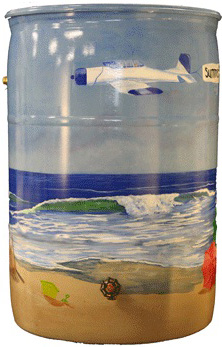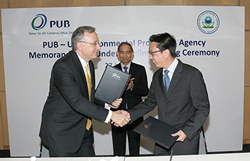Rain Barrel Workshop Provides Educational Fun
By Kevin Kubik
My wife and I attended a rain barrel workshop in Eatontown, NJ. The workshop was on teaching people about water conservation and reducing storm water runoff in our communities and making rain barrels. The best part of the workshop was that they gave us everything we needed to make our own rain barrel including the barrel, a spigot and all the fittings.
It was a lot of fun hearing about the program and making the rain barrel. Special instructions were given on how to connect two or more rain barrels in a series to make greater use of big rain events, what to water with the collected water (lawn and garden watering) and what to avoid (consumption). Everyone was also shown a couple of ways to avoiding mosquito breeding in the rain barrel.
I was so impressed with the presentation that I asked the instructor, Sara Mellor, if she could come to our next divisional “All Hands” meeting to give us a short presentation. She even gave us our own rain barrel that we will use in our Edison rain garden.
The workshop was provided by the Rutgers Cooperative Extension Water Resources Program, Water Conservation Program, which is a collaborative initiative between Rutgers Cooperative Extension Water Resources Program and the New Jersey Department of Environmental Protection via funding from the U.S. Environmental Protection Agency. The link to the rain barrel program is http://water.rutgers.edu/Stormwater_Management/rainbarrels.html. Check it out.
Every year, as part of “Rutgers Day,” a contest is held for the best painted rain barrel. There’s even a video on how to paint a rain barrel: http://www.youtube.com/watch?v=BVtLTkGO3zs&feature=youtu.be.
About the Author: Kevin Kubik is the region’s Deputy Director for the Division of Environmental Science and Assessment out of EPA’s Edison Environmental Center. He has worked as a chemist for the region for more than 31 years in the laboratory and in the quality assurance program.













 While you’re shopping:
While you’re shopping: Did you know that you could help sustain underground aquifers with your choice of how you get clean? I live in Kansas, and we, like other Midwest states, are in extreme drought conditions with no rain replenishing our aquifers. Taking long showers or full tub baths impacts the hydrologic cycle, taking out more water than can be quickly returned.
Did you know that you could help sustain underground aquifers with your choice of how you get clean? I live in Kansas, and we, like other Midwest states, are in extreme drought conditions with no rain replenishing our aquifers. Taking long showers or full tub baths impacts the hydrologic cycle, taking out more water than can be quickly returned.